|
|
| |
|
| |
|
| |
|
| |
|
| |
|
| |
[This
is Part 2 of a 4-Part series]
The
Museum of the Confederacy (MOC) celebrates Robert E. Lee
and Jefferson Davis as heroes and has sought to “honor”
them by offering a Lost Cause view of the Civil War and
promoting Confederate nationalism. The very reason for
the existence of the Confederacy was white supremacy and
slavery. On these issues, the historical record pertaining
to both Lee and Davis is clear, and should be central
to any historical assessment of these figures. Yet the
MOC obscures this history, choosing instead anecdotes,
trivia, artifacts and peripheral issues. Both Davis and
Lee betrayed the United States of America, led an insurrection
that resulted in the deaths of 600,000 Americans, and
fought to dissolve the United States. Both Lee and Davis
were white supremacists who believed in slavery and consistently
denigrated African Americans. During Reconstruction, Lee
in particular worked to deny African American basic civil
rights in particular the right to vote. [1] That either would be “commemorated” or “celebrated” or “honored”
in any century is revolting, let alone at the start of
the 21st century. Yet, this is precisely what
the MOC does.
In
1999, Confederate Veteran magazine previewed the
MOC’s forthcoming Robert E. Lee exhibition. Describing
Lee as “a man made a hero in his time, and a legend after
his death,” the exhibition was to be the MOC’s year-long
“commemoration” of Lee’s 130th birthday.
[2] To coincide with the exhibition, the MOC hosted
a “Celebrate South Ball,” to “honor” Lee. Explaining the
Ball, Sarah Meadows Brown, Director of MOC Development,
and Douglas G. Knapp, Associate MOC Executive Director
stated:
What better way to bring in the year
2000 than to recognize Gen. Robert E. Lee at our Ball!
As you know, the year 2000 will be the year of Lee at
the Museum. The Museum’s annual fund raising ball will
also turn its attention to this distinguished Southern
hero. Since Lee embodies the entire South, we are taking
a year off from honoring a particular state.
Besides
asserting that Lee is a “hero,” for which it might be
asked to whom in the South Lee is a “hero,” there is an
underlying assumption that the Confederacy and the South
are one and the same. It also has to be asked if African
Americans would be “embodie[d]” by Lee, who is supposed
to represent the “entire South.”
[3] Also previewed in the magazine is the MOC’s “Grand
Old Days Carnival,” which raises the question for whom
these “Old Days” were “Grand”?
[4]
Shortly
after the MOC’s Lee exhibit opened, Confederate Veteran
proclaimed “General Lee Lives at The Museum of the
Confederacy!” Reminding SCV members that “J.E.B. Stuart,
IV, great-grandson of the Confederate general is the Museum’s
Board President” and he is “a distinguished member of
the SCV, and an active member of the Military Order of
the Stars and Bars,” this article also informed readers
that the Lee exhibit concludes with a poster published
by the SCV “advocating the restoration of the Lee mural
on the floodwall in Richmond, Virginia,” a painting that
had caused great controversy in the mid-1990s. [5]
Writing
about the exhibit in the Museum of the Confederacy
Newsletter, John Coski discusses the first draft of
Lee’s letter of resignation from the U.S. Army, April
20, 1861, which was to be displayed by the MOC. It includes
a sentence that forms the basis of the old Lost Cause
justification for Lee’s treason, quoting, “Save in the
defense of my native state, I never desire again to raise
my sword.” Coski discusses the editing of the letter as
revealed by the first draft, remarking that it is “dramatically
shown” how “Lee made changes in style and in language
calculated to make the letter more eloquent.” What is
missing is any critical review of the letter regarding
his resignation from the U.S. military during a time of
dire need of the American republic for loyal officers;
nor is there any discussion of Lee violating his Oath
of Allegiance to the United States as a U.S. military
officer. Instead, the letter and the Lost Cause justification
are showcased and left unexamined.

Coski
then proceeds to describe the artifacts that will be shown
at the exhibit, such as locks of Lee’s hair and a letter
Lee wrote giving a subordinate permission to marry, “with
a warmth and effusiveness that will surprise those who
believe Lee to have been stiff and formal.” Coski comments
that Lee became a hero in the late 19th and
early 20th centuries “even by those who fought
against him and his armies.” Announced in the article
is “a lavishly-illustrated guide to the Museum’s object
and library collections relating to Lee’s life.”
[6] Both the Confederate Veteran and Coski
articles lack any critical view of Lee or the Confederacy.
Lee’s white supremacist views and advocacy of slavery
are avoided, Coski at one point even hinting that Lee
was an abolitionist, by describing that the MOC exhibit
will display, “the December 1862 document by which Lee
emancipated the 63 slaves of his late father-in-law, George
Washington Parke Custis.” The reality was quite different.
Lee was obligated under the terms of Custis’ will (which
left the slaves to him) to emancipate the slaves in five
years. [7]
Further, the historical record is that before the Civil
War two of the slaves Lee inherited tried to escape. They
were captured and brought back to Lee’s plantation, where
they were whipped and brine poured into their wounds.
One of Lee’s slaves who suffered this treatment was Wesley
Norris who, in a 19th century interview, described the
event:
I was born a slave on the plantation
of George Parke Custis; after the death of Mr. Custis,
Gen. Lee, had been made the executor of the estate, assumed
control of the slaves of Mr. Custis, in number about seventy;
it was the general impression among the slaves of Mr.
Custis that on his death they should be forever free;
in fact this statement had been made to them by Mr. C
years before; at his death we were informed by Gen. Lee
that by the conditions of the will we must remain slaves
for five years; I remained with Gen. Lee for about seventeen
months, when my sister Mary, a cousin of ours, and I determined
to run away, which we did in the year 1859; we had already
reached Westminster, in Maryland, on our way to the North,
when we were apprehended and thrown into prison, and Gen.
Lee notified of our arrest; we remained in prison fifteen
days, when we were sent back to Arlington, we were immediately
taken before Gen. Lee, who demanded the reason why we
ran away; we frankly told him that we considered ourselves
free; he then told us he would teach us a lesson we never
would forget; he then ordered us to the barn, where, in
his presence, we were tied firmly to posts by a Mr. Gwin,
our overseer, who was ordered by Gen. lee to strip us
to the waist and give us fifty lashes each, excepting
my sister, who received but twenty; we were accordingly
stripped to the skin by the overseer, who, however had
sufficient humanity to decline whipping us; accordingly
Dick Williams, a county constable, was called in, who
gave us the number of lashes ordered; Gen. Lee, in the
meantime, stood by, and frequently enjoined Williams to
‘lay it on well,’ an injunction which he did not fail
to heed; not satisfied with simply lacerating our naked
flesh, Gen. Lee then ordered the overseer to thoroughly
wash our backs with brine which was done.
At
the end of this interview, Norris states that there were
at least a dozen witnesses to substantiate his statements. [8] The old expression “salt in the wounds” refers
to the searing burning pain of having salt placed into
a would. The brine in Norris and his sister’s wounds would
have been agonizing. [9]
The
comments by Norris make it clear that Robert E. Lee was
a man who had people tortured by having them tied up,
whipped, and left in agony with brine poured on their
wounds. This is the Lee that the MOC fails utterly to
describe.
There
is nothing in any of the articles about the Lee exhibit
to suggest that it presents anything critical of Lee or
even mentions Lee’s white supremacist views and support
for slavery. His post-Civil War efforts to deny African
Americans civil rights during Reconstruction are also
elided. Rather, the MOC and SCV understands the exhibition
as celebrating Lee. Although technically the MOC might
point out that they have merely assembled historical artifacts
concerning an important person, it is clear that the MOC’s
Lee is sanitized to become the sainted figure of the 19th
century Lost Cause and current neo-Confederate groups.
[10]
The
MOC’s Jefferson Davis exhibition in 2008, to celebrate
the Confederate President’s 200th birthday, presented
a similarly partial and sanitized historical record, lacking
in any critical analysis, and instead touting Davis as
a patriot.
A
MOC press release announcing “Jefferson Davis’s 200th
Birthday Party: The Museum of the Confederacy Commemorates
the President of the C.S.A” offered free admission to
the museum on June 3, 2008 (when Davis would have been
200), speeches, a re-enactor to enable “photo-ops from
the president himself,” and even “cake in the garden.” [11]
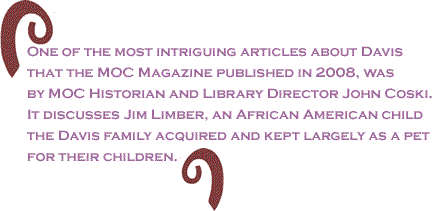
Like
Robert E. Lee, the historical record regarding Davis reveals
a staunch advocate of white supremacy and slavery - positions
that Davis stated consistently and regularly throughout
his life - but ones that the MOC exhibition ignores. For
example, in 1853, white supremacist J. H. Van Evrie published,
“Negroes and Negro Slavery; The First an Inferior Race
– The Latter, Its Normal Condition.” It contained a letter
of endorsement from Davis, who at the time served as U.S.
Secretary of War. “I have read the enclosed pages with
great interest,” commented Davis, “not as a Southern man
merely, but as an American, I thank you for your able
and manly exposure of a fallacy which more than any or
all other causes has disturbed the tranquility of our
people and endangered the perpetuity of our constitutional
union.” [12] The “fallacy” was that African Americans
were human. For Van Evrie, and his patron Davis, they
were not. [13] Arguing that Africans were a species of mammal
that could be categorized somewhere between white men
and orangutans, Van Evrie rhetorically asked:
…should we therefore attempt, in
all respects, to make the Negro our equal, and deny to
the Ouran-Outan everything? Or rather, should we not,
in conformity with the eternal and immutable facts of
nature, grant to the Negro all that he possesses in common
with us, and no more; and to the Ouran-Outan, and still
inferiour creatures, what belong to them, or have consideration
for them to the extent that they approximate to us? Unfortunately,
the distinctions that separate, yet bind closely together,
all the species of men, have not been investigated or
understood, and a few general resemblances have been confounded
and mistaken, so that a very large portion of mankind
are entirely ignorant of their true character. [14]
Of
course, this is not the Davis that the MOC exhibited in
2008. Instead the MOC offered “Christmas with the Davis
Family,” “a tour of the Davis’ Christmas decorated White
House,” [15] and a Jefferson Davis Dog Walk. [16] Other essays in MOC Magazine detail
the museum’s “Hearts At War... program about Civil War
Valentines,” that “examined the marriage of Varina and
Jefferson Davis”; displays like “Dressing in a Hurry,”
about how women dressed in the 19th century;
“Hello, Dolly, Dolls and Paper Dolls in the South”; “Bedlam
Broke Loose,” about the Davis children in the Confederate
White House; and “To Take Tea,” an event that will “show
off pieces in the Museum’s tea service”.
[17] Also announced is a “Walking Tour of ‘Jefferson
Davis’ Richmond,” which “incorporates anecdotes about
Jefferson Davis … and stories of life in Richmond during
the Civil War.” [18] Such trivialities abound. Davis’s views on
race and slavery are avoided, although James Redpath,
an abolitionist and contemporary of Davis, is quoted as
saying “Lest any foreigner should read this article, let
me say for his benefit that there are two Jefferson Davises
in American history — one is a conspirator, a rebel, a
traitor … the other was a statesman with clean hands and
pure heart.” [19]
As
2008 progressed, other MOC Magazine articles reiterated
traditional Lost Cause narratives and assertions concerning
Davis. One such piece describes Davis’s imprisonment and
proposed trial. The article informs the reader that “the
government hoped to pack the jury with Unionists, including
African-Americans. Photographs showing the mixed race
grand jury that indicted Davis and mixed race petit jury
pool to try the Confederate president became propaganda
tools in the South.” However, since this was to be a jury
in Virginia, it would seem that some African Americans
would be in the jury unless there was a policy to exclude
them and is hardly a matter of some conspiracy. The article
doesn’t mention why a photo of a mixed race jury
would be a propaganda tool. It would incense racist whites,
largely ex-Confederate supporters, who would think it
an outrage that an African American would be on a jury
to try a white person. In contrast, biracial coalitions
trying to build the first multiracial democracies in the
South would likely welcome the jury composition. [20] Additionally, there is no
discussion that Davis was outraged by African Americans
being on juries during Reconstruction. [21]
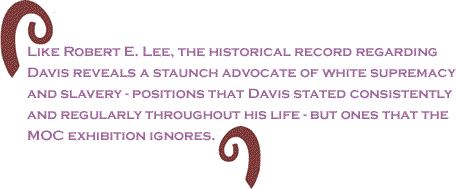
The
MOC magazine promoted the museum’s 2008 Symposium “Jefferson
Davis: A Man in Full,” stating “Jefferson Davis is rather
like the Rodney Dangerfield of the Confederacy. He rarely
receives the respect – or the attention – that he deserves.”
[22] In the summary transcript of the Symposium held
at, and co-sponsored by, the Library of Virginia, William
C. Davis evaluates Jefferson Davis on his executive effectiveness,
using criteria such as “Staffing decisions,” where we
learn that Jefferson Davis made poor decisions about Confederate
generals. Race and slavery don’t even come up as a topic;
Joan E. Cashin discusses the marriage of Jefferson Davis
to Varina Howell Davis; and, William J. Cooper discusses
“Jefferson Davis, Abraham Lincoln, and the Crisis of 1860-1861,”
which was mostly about the election of 1860 and secession.
Slavery is mentioned in passing as an issue in the South.
Davis’ views on race and slavery are not mentioned. Finally,
Donald Collins discusses the post-war evolution of the
image of Jefferson Davis in the Lost Cause view of the
Civil War. This Symposium regarding the “Man in Full,”
however, avoids the central issues of Davis’s life, political
career, and the Confederacy: race and slavery.
[23]
One
of the most intriguing articles about Davis that the MOC
Magazine published in 2008, was by MOC Historian and
Library Director John Coski. It discusses Jim Limber,
an African American child the Davis family acquired and
kept largely as a pet for their children. Coski rightly
rejects some neo-Confederate assertions that Limber was
adopted, but writes in such a manner as to suggest that
Limber and Davis lived together in an integrated family
that somehow wasn’t racist. The Davis family lore that
they rescued Limber from an abusive African American guardian
isn’t challenged by Coski, who asserts that Limber was
a protégé, not a pet, as “The Davises clearly assumed
responsibility for him and there was obviously affection
between him and his sponsors.” The “affection” and “responsibility”
were, however, easily discarded. After the fall of the
Confederacy, the Davis family handed Limber to the Union
General Saxton; thereafter Limber was never again part
of the Davis household. [24]
Repeating
the old slaveholder idea of the ‘peculiar institution’
and the patriarchal idea of the slaves being a part of
one happy family, Coski writes:
“The evidence suggests that he was
a member of the Davis family in the same way that slaves,
servants, and other dependents were members of white families
- with real mutual responsibility and affection.”
This
is the MOC’s major story in its 2008 assessment of Davis
and African Americans, and it is a retelling of the neo-Confederate
narrative regarding Limber, albeit stripped of its most
obviously questionable elements, to portray Jefferson
Davis as the father of a multiracial household. [25] The Jim Limber story serves as the example
put forth by the MOC of Davis and his personal dealings
with African Americans. A more representative story would
be the mortality of the slaves on Davis’s Brierfield plantation
in Mississippi where many were worked to death. As William
J. Cooper explains in Jefferson Davis, American,
“The continuing imbalance towards younger slaves on Brierfield
strongly indicates that only a small percentage of Davis’s
bonds people lived past forty,” and “This rarity of the
elderly also helps explain why the master of Brierfield
evinced such affection for the ancient slave known as
Uncle Bob. He had practically no peers.” [26] Cooper was interviewed by Coski for the MOC
Magazine, but in a way that enables the museum to
claim that it deals with issues of slavery and race, but
simultaneously both minimizes and obscures these issues. [27]
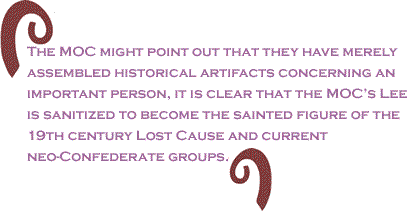
The
interview starts discussing why Davis was an important
19th century figure. Cooper asserts that Davis
had a national following, explaining that “he had a very
warm welcome in Maine and New York and Boston.” What Cooper
doesn’t discuss is the content of these well-received
speeches. In Augusta, Maine, in 1858, for example, Davis
praised his audience for remaining racially pure, in contrast
to Latin Americans who he said were racially mixed and
incapable of self-government. [28]
Cooper
then suggests that Davis was not a strong believer in
slavery and its expansion. Rather, “He believed, of course,
that southerners had the right to take slavery into all
the national territories, but he was willing to compromise
in that. He was not insistent that the South be given
that right in every territory.”
[29] “As early as 1848,” Cooper continues, Davis
“was willing to accept some sort of boundary line,” claiming
that it is a myth “that Davis tried to get a slave code
through the United States Congress, so that the United
States Congress would pass a law regarding slavery in
the territories... but all he wanted the Senate to do
was to affirm that the South had the constitutional right
to take slavery into the territories, a right that had
been decreed by the Dred Scott decision.” These comments
portraying Davis as a pro-slavery moderate contradict
both the historical record and Cooper’s own previous work
in which he describes Davis’s rage at the admission of
California as a free state:
His feelings about California bored
so deep that he even entertained the notion of physically
taking the California bill from the secretary of the Senate
and “tearing it to pieces,” but because only six other
southern senators indicated a willingness to participate,
the great ripping never occurred. [30]
Davis
similarly opposed efforts to ban slavery in the Oregon
territory in 1848. Defending slavery in a lengthy Senate
speech, Davis described the inhabitants of Oregon and
the newly acquired territories from Mexico as “mongrels
of the Spanish and Indian races, inheriting from both
the characteristics, pertinacity, treachery, and revenge.”
In the speech he advocated an amendment precluding the
Oregon territory legislating on slavery while it was a
territory, concluding with the statement, “If this amendment
be rejected, I shall view it as ominous of the future,
and stand prepared for whatever consequences may follow.”
[31] This was obviously a threat of possible secession.
Oregon would have been north of any pre-Civil War compromise
boundary line for slavery.
Cooper’s
exculpatory language, “but all he wanted” and “was willing
to accept,” seeks to minimize what Davis demanded, namely
to expand the slavery, both over vast territories within
the continental United States and also to Cuba, which
Davis sought to annex.
Davis
had a consistent extreme pro-slavery career. When the
bill to fund the American ships in the African Squadron,
a multinational squadron of ships to suppress the Transatlantic
slave trade, came up for a vote, Davis spoke out against
it stating “I was always opposed to the African squadron,
and am now in favor of its withdrawal,” concluding “With
great deference, I think the whole movement wrong. Our
laws should be confined to our own country, for which
alone we may decided either in morals or policy. As an
indication of my opinion, I will vote against reference
of this resolution.” The resolution passed 45-9 showing
that Davis was distinctly in the minority as a member
of the Senate’s strongest pro-slavery faction. [32]
Davis
again demonstrated his extreme pro-slavery credentials
in 1860. Three slave ships had been captured and 1,432
slaves were held in Key West. The problem arose that the
marshal for Southern Florida had to take care of them.
Congress was in session and U.S. Senator Judah P. Benjamin
of Louisiana, a slave state, introduced a bill to appropriate
$250,000 to repatriate them to Africa and provide some
limited support when they were landed in Liberia. It passed
easily in the House. In the Senate it passed 41 to 14:
Davis voted against the measure. If the United States
government didn’t have a means to handle freed slaves
captured from slave ships other than selling them into
slavery, it is unclear how the U.S. government would be
able to continue to capture slave ships. Of those suffering
on this slave ship, 294 died at Key West and 245 failed
to survive the return to Liberia. [33]
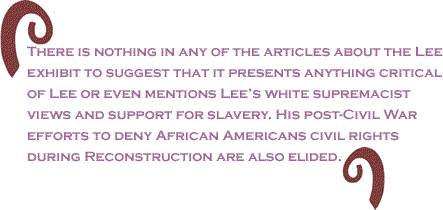
These
two legislative matters reveal Davis for who he was, but
for the MOC it wouldn’t do to dwell on these matters or
even bring them up; it might spoil the fun of tea parties,
discussions of Davis’s Christmas and the antics of his
children!
Cooper,
after his explanation of Davis’s politics of slavery,
then attempts to position him as a reluctant secessionist,
explaining:
Davis was always trying to find some
way around what would be a cataclysm. And after Lincoln’s
election, he urged the South Carolina Fire-Eaters to hold
off, not to secede right away, even telling them he didn’t
understand what the pulse of Mississippi was, despite
the fact that he’d just been campaigning in Mississippi.
When the governor of Mississippi had a meeting of the
Mississippi congressional delegation in Jackson following
Lincoln’s election to try to get the sense of his congressional
delegation and what he should propose in the legislature,
Davis was the only one who urged caution, didn’t want
anything done too quickly.
[34]
Yet,
quotes from a speech Jefferson Davis made to the Mississippi
legislature Nov. 16, 1858, a little more than two years
prior to the start of the Civil War, give a better understanding
of Davis and secession. In the speech, Davis explains
that in the next U.S. House the “Abolitionists and their
allies” will likely have control, but their legislation
against slavery can be vetoed by the president (James
Buchanan), but that in the following election in 1860,
the president elected “Whether by the House or by the
people,” might be an abolitionist. For this eventuality
Davis urges secession, as an abolitionist government is
“entitled to no respect,” demanding that:
In that event, in such manner as
should be most expedient, I should deem it your duty to
provide for your safety outside of a Union with those
who have already shown the will, and would have acquired
the power, to deprive you of your birthright and to reduce
you to worse than the colonial dependence of your fathers.
Towards
the end of the speech Davis further counsels the legislature
of Mississippi as follows:
As when I had the privilege of addressing
the Legislature a year ago, so now do I urge you to the
needful preparation to meet whatever contingency may befall
us. The maintenance of our rights against a hostile power
is a physical problem and cannot be solved by mere resolutions.
...due provision should be made ...should not the State
have an armory for the repair of arms, for the alteration
of old models so as to make them conform to the improved
weapons of the present day, and for the manufacture on
a limited scale of new arms, including cannons and their
carriages; the casting of shot and shells, and the preparation
of fixed ammunition?
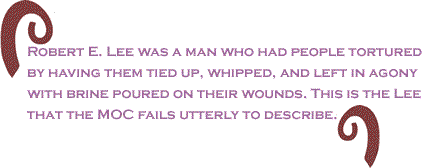
Such preparation will not precipitate
us upon the trial of secession... [but] in the event that
separation shall be forced upon us, we shall be prepared
to meet the contingency with whatever remote consequences
may follow it, and give to manly hearts the happy assurance
that manly arms will not fail to protect the gentle beauty
which blesses our land and graces the present occasion.
[35]
Davis
did not hope a civil war would come, but that didn’t mean
that he wasn’t ready to secede if he felt the slavery
was threatened, and demand that Mississippi be prepared
to fight to secure its white supremacist future upon secession.
Mississippi
would secede in January 1861 and, two years later, when
Lincoln issued the Emancipation Proclamation in 1863,
Jefferson Davis raged against this declaration that mandates
“all slaves within ten of the States of the Confederacy
to be free” as “the most execrable measure recorded in
the history of guilty man.” “We may well leave it to the
instincts of that common humanity,” Davis continued, “
…to pass judgment on a measure by
which several millions of human beings of an inferior
race, peaceful and contented laborers in their sphere,
are doomed to extermination, while at the same time they
are encouraged to a general assassination of their masters
by the insidious recommendation “to abstain from violence
unless in necessary self-defense.” … I confine myself
to informing you that I shall, unless in your wisdom you
deem some other course more expedient, deliver to the
several State authorities all commissioned officers of
the Unites States that may hereafter be captured by our
forces in any of the States embraced in the proclamation,
that they may be dealt with in accordance with the laws
of those States providing for the punishment of criminals
engaged in exciting servile insurrection. [36]
As
regarding the use of African American troops in the American
army, Jefferson Davis issued a proclamation including
the following:
3. That all Negro slaves captured
in arms be at once delivered over to the executive authorities
of the respective States to which they belong, to be dealt
with according to the laws of said States.
4. That the like orders be executed
in all cases with respect to all commissioned officers
of the United States when found serving in company with
armed slaves in insurrection against the authorities of
the different States of this Confederacy.
[37]
The
“laws of said States” would be that aiding an insurrection
of slaves is punishable by death
Despite
such fulminations by Davis, Cooper’s discussion/interview
about Davis during the Civil War hints that Davis changed
his racial attitudes, becoming less racist and favoring
African American Confederate troops:
He led the Confederacy through its
short violent history, and in doing so, he moved the South
by 1865 in directions no one in 1861 could have fathomed.
He even advocated putting slaves in uniform by 1865. And
nobody in the South could have possibly conceived of that
in 1861. [38]
It
is true that in utter desperation for troops in 1865,
and fear that if the Confederacy didn’t use African Americans,
invading United States armies would, that the Confederacy
did intend to utilize African American troops, but it
was so late in the war that it is unclear whether any
were actually fielded. The record of the Civil War is
a record of atrocities and massacres of African American
troops by Confederate soldiers and Davis did indeed take
the South “in new directions.”
Cooper’s
does say that secession was connected to slavery and it
wasn’t an issue of tariffs, but he further explains that
it was really a question of honor because people in the
“Republican Party didn’t just say that we’re opposed to
slavery. They called slavery un-American, that you could
not be a good American and support slavery,” further explaining
“honor... was, of course, a very important concept in
the antebellum South. You didn’t take insults easily.”
In Cooper’s assessment, therefore, the abolitionists caused
the Civil War because they insulted Southern slave owners
as “un-American.” Slavery itself, however, was not really
the issue.

MOC
official John Coski asks Cooper why his book is entitled,
“Jefferson Davis, American.” Cooper explains that Jefferson
Davis was really a very patriotic American and was very
sad to have to secede: “he said to the end of his life,
the saddest day of his life was the day he gave his farewell
speech to the United States Senate in January 1861, because
the America he cherished disappeared.” This “cherished”
America, Cooper comments, supported slavery. Cooper also
suggests that Davis saw Confederate secession as equivalent
to the American Revolution, however, here Cooper’s arguments
confuse and obscure the issue: Davis supported slavery
first and last; if other institutions supported slavery,
Davis supported them; if an institution ceased to support
slavery, he opposed it. Davis’s identification with the
leaders in the American Revolution, and George Washington
in particular, was that he saw them as the leaders of
a slave owning republic who supported slavery.
Cooper
does say that Jefferson Davis thought Reconstruction was
“horrible” because “he didn’t think the blacks were capable
of participating in politics” and that “he was delighted
when Reconstruction came to an end.” Cooper also says
that Davis “thought what most white southerners thought.”
This, of course, wasn’t necessarily what all people in
the South thought. Reconstruction is the story of biracial
majorities being defeated not at the polls, but by white
terror, atrocities and murders by ex-Confederates acting
as Ku Klux Klans, Knights of the White Camellias, the
White League, and the Red Shirts. This is the course that
Davis supported; violence and terror, not democracy. Yet,
Cooper concludes by saying that says Davis was “delighted
that the native white southerners regained control in
the South,” as if it were home rule, instead of stating
that Davis was delighted that white supremacy was restored.
What Cooper says about Davis’s views is correct, but why
Davis held these views is omitted.
[39]
Cooper
ends by mentioning that Davis’s book, “The Rise and Fall
of the Confederate Government” finishes with a Latin sentence
stating that the Union should remain together forever.
Curiously this major book by Davis, in which he articulates
his opinions, is only mentioned once by Cooper. A more
informative a discussion of the “Man in Full,” would have
been to discuss Davis’s views on race and slavery as portrayed
in his one major literary work. These views were unchanged
from before the Civil War. Davis felt that African Americans
were racially inferior, that emancipation was a mistake,
and that it was an outrage that African Americans were
allowed on juries and in state legislatures, among other
things. Davis died never regretting his lifelong fight
for slavery nor altering his views regarding African Americans. [40]
Cooper
also takes time in this interview to take a knock on Abraham
Lincoln, attributing his great reputation to his being
assassinated.
Perhaps
the most interesting obfuscation of the issues of the
life of Jefferson Davis is given by the MOC’s President
and CEO S. Waite Rawls III when he spoke at a United Daughters
of the Confederacy event. UDC Magazine quotes Rawls
as saying that:
What stands out among modern historians
is Jefferson Davis’ strong will and his passion, determination
and commitment to the cause that he undertook in 1861,
although he was reluctant to become the President of the
Confederacy. Whether criticized or praised, all writings
mention his unyielding commitment to the Confederacy.
Praising Cooper’s Jefferson Davis,
American , Rawls comments that Cooper understands
that “Davis saw nothing wrong with the experience of slavery
and states’ rights, and would have been puzzled by our
questions today about both slavery and the Confederacy.”
[41]
This
is a nonsensical assessment. Given that Davis was a U.S.
Senator that heard frequently from, and knew of the views,
of abolitionists, would he really be “puzzled by our questions...
about slavery”? Is Rawls arguing that the concept of anti-slavery
was beyond Davis’ comprehension because of the historical
period he lived in so he is blameless for his strong pro-slavery
views?
The
statement implies that the relevant issue of Davis’s life
history is his commitment to the Confederacy. This should
be the criteria by which we should judge Davis; not his
views on race and slavery. Commentaries like those of
Cooper and Rawls, are examples of how the MOC evades the
issues of the race and white supremacy as they pertain
to Civil War and the Confederacy.

Click
here
to read any of the parts in this series.
BlackCommentator.com Guest Commentator, Edward H. Sebesta, is co-editor of Neo-Confederacy: A Critical Introduction
(University of Texas, 2008) and The Confederate and
Neo-Confederate Reader: The ‘Great Truth’ of the ‘Lost
Cause’ (University Press of Mississippi, 2010) Click
here
to contact Edward Sebesta.
End Notes
[1] Nolan, Alan T., “Lee Considered:
General Robert E. Lee and Civil War History,” University
of North Carolina Press, Chapel Hill, 1991. For Lee’s
views on slavery and his involvement in it, pages 9-29.
For Lee’s opposition to civil rights for African Americans,
pages 134-152.
[2] “Notices: R.E. Lee: The Exhibition
Opens at the Museum of the Confederacy, January 16, 2000,”
Confederate Veteran, pages 45-46.
[3] Brown, Surah Meadows, and Knapp,
Douglas G., “Lee Leads the Ball,” Museum of the Confederacy
Newsletter, Fall/Winter 1999/2000, page 10.
[4] “Notices: R.E. Lee: The Exhibition
Opens at the Museum of the Confederacy, January 16, 2000,”
Confederate Veteran, pages 45-46.
[5] For discussion of the controversy,
see Jonathan I. Leib, “Robert E. Lee, ‘race,’ representation
and redevelopment along Richmond, Virginia’s Canal Walk,”
Southeastern Geographer, 44.2 (2004), 236-262.
[6] Coski, John M., “Exhibit and Book
will mark Year of Lee,” The Museum of the Confederacy
Newsletter, Fall/Winter 1999/2000, pages 6-8.
[7] Nolan, Alan, T, ““Lee Considered:
General Robert E. Lee and Civil War History,” University
of North Carolina Press, Chapel Hill, 1991, page 16.
[8] Norris, Wesley, Interview circa
1866, in John W. Blassingame’s “Slave Testimoney: Two
Centuries of Letters, Speeches, Interviews, and Autobiographies,”
Louisiana State University Press, Baton Rouge, 1977, pages
467-68.
[9] For a graphic account what a whipping
with salt placed in the wounds afterwards see Campbell,
Randolph B., “An Empire for Slavery: The Peculiar Institution
in Texas,” Louisiana State University press, Baton Rouge,
1989, page 147.
[10] Harhai, Courtney M., “General Lee
Lives at The Museum of the Confederacy!,” Confederate
Veteran, Vol. 2 2000, pages 14-16.
[11] Stagg, Megan, “Jefferson Davis’s
200th Birthday Party,” Press Release of the
Museum of the Confederacy, 5/12/2008,
printed out 2/27/2011. See also “Jefferson Davis’ 200th
Birthday Celebration,” “Upcoming Events,” The Museum
of the Confederacy Magazine, Spring 2008, back cover.
[12] Van Evrie, J.H., “Negroes and Negro
“Slavery;” The First an Inferior Race – The Latter, Its
Normal Condition,” Day Book Office, New York, 1853, letter
reprinted inside front cover.
[15] No author, “Christmas With the Davis
Family,” “Upcoming Events,” The Museum of the Confederacy
Magazine, Summer 2008, back cover. This even is also
listed in the “Upcoming Events” section in the Fall 2008
issue.
[16] Boltz, Martha A., “Commemorating
Jefferson Davis’ Life and Legacy: 42nd Annual
Massing of the Flags,” UDC Magazine, pages 14-15,
with a report of S. Waite Rawls III, President of the
MOC reporting on upcoming activities.
[17] Stagg, Megan, “Jefferson Davis —Patriot
& Paradox: Commemorating the 200th Birthday
of the President of the C.S.A.,” Museum of the Confederacy
Magazine, Winter 2008, pages 12-14, activities on page
13.
[18] No author, “Walking Tour of ‘Jefferson
Davis’ Richmond,” Museum of the Confederacy Magazine,
Spring 2008, back cover.
[19] Stagg, Megan, “Jefferson Davis —Patriot
& Paradox: Commemorating the 200th Birthday
of the President of the C.S.A.,” The Museum of the
Confederacy Magazine,” Winter 2008, page 12-14.
[20] Coski, John M., “Bottimore Lecture
Will Explore ‘The Trial of the (19th) Century,”
Museum of the Confederacy Magazine, Summer 2008, pages
14-17.
[21] Davis, Jefferson, “The Rise and
Fall of the Confederate Government,” Vol. 2, De Capo Press,
New York, 1990, reprint of the 1881 edition, pages 628-29,
text and footnote.
[22] No author, “2008 Symposium Explores
Life and Legacy of Jefferson Davis,” Museum of the Confederacy
Magazine, Fall 2007, page 8.
[24] Botume, Elizabeth Hyde, “First Days
Among the Contrabands,” Lee and Shepard Publishers, Boston
1982, pages 181-190.
[25] Coski, John M. “What Do We Really
Know about ‘Jim Limber’,” Museum of the Confederacy Magazine,
Winter 2008, pages 18-19.
[26] Cooper, William J., “Jefferson Davis,
American,” Alfred A. Knopf, 2000, page 248. Reported average
life spans in history are greatly influenced by infant
mortality and the mortality of children. It is a common
place in high school history classes for teachers to explain
that just because the average life span was very low,
that didn’t mean there weren’t old people around in the
past. Even in the past, if you made it to be 15 years
old you had a fairly good chance to make it to be 60 years
old. To have a mortality curve truncate around the age
of 40 years, is indicative of something morbid and is
sinister. Cooper’s rationalizations and excuses for this
truncation on Brierfield are appalling.. As Cooper explains
in his book, Jefferson Davis was a steady purchaser of
slaves, most whom would have been at least in their teenage
years if not young adults. With this in mind it can be
assumed that the Brierfield worked its slaves to an early
death. Cooper discusses Davis’ purchase of slaves on pages
248-250.
[27] Coski, John M., Interview with William
J. Cooper, Transcribed by Trucker H. Hill, “‘We should
be trying to understand Davis and the Confederacy,’”:
An Interview with Prof. William J. Cooper, Jr.,” Museum
of the Confederacy Magazine, Spring 2008, pages 7-13.
[28] Davis, Jefferson, “Speech of Jefferson
Davis at the Portland Convention,” Vol. 3 pages, 284-88,
and “Speech of Jefferson Davis at State Fair at Augusta,
Me. ,” from the Eastern Argus, Sept. 29, 1858,
reprinted Vol. 3, pages 312-314, both from “Jefferson
Davis: Constitutionalist, His Letters , papers, and Speeches,”
editor Dunbar Rowland, Mississippi Department of Archives
and History, Jackson, 1923.
[29] Coski, John M., Interview with William
J. Cooper, Transcribed by Trucker H. Hill, “‘We should
be trying to understand Davis and the Confederacy,’”:
An Interview with Prof. William J. Cooper, Jr.,” Museum
of the Confederacy Magazine, Spring 2008, pages 7-13.
[30] Cooper, William J, “Jefferson Davis,
American,” Alfred A. Knopf, New York 2000, page 217.
[31] Davis, Jefferson, Speech on the
floor of the U.S. Senate, July 12, 1848, Appendix to the
Congressional Globe, 30th Congress, 1st
Session, pages 907-914.
[32] Congressional Globe, 31st
Congress, 2nd Session, pages 307-309.
[33] Fehrenbacher, Don Edward, McAfee,
Ward M., “The Slaveholding Republic: An Account of the
United States government’s relations to slavery,” Oxford
University Press, New York, 2001, page 188. The vote is
on page 2309 in the Congressional Globe, Senate,
36th Congress, 1st Session.
[34] Coski, John M., Interview with William
J. Cooper, Transcribed by Trucker H. Hill, “‘We should
be trying to understand Davis and the Confederacy,’”:
An Interview with Prof. William J. Cooper, Jr.,” Museum
of the Confederacy Magazine, Spring 2008, pages 7-13.
[35] Rowland, Dunbar, “Jefferson Davis
Constitutionalist: His Letters, Papers, and Speeches,”
Vol. III, Mississippi Department of Archives and History,
Jackson, 1923, speech on pages 339-360, quotes on pages
356, 359.
[36] Dunbar Rowland, “Jefferson Davis to the Confederate Congress,” from
Jefferson Davis Constitutionalist: His Letters, Papers,
and Speeches, 5, (Jackson: MS Dept. of Archives
and History, 1923), 396-415. Also in the Journal of
the Confederate Congress, 3, 58th
Cong., 2d sess., 1904, S. Doc. 234, Serial 4612, 13-14.
[37] Official records of the Union and Confederate Navies in the War of
the Rebellion. / Series II - Volume 3: Proclamations,
Appointments, etc. of President Davis; State Department
Correspondence with Diplomatic Agents,etc., page 142.
[38] Coski, John M., Interview with William
J. Cooper, Transcribed by Trucker H. Hill, “‘We should
be trying to understand Davis and the Confederacy,’”:
An Interview with Prof. William J. Cooper, Jr.,” Museum
of the Confederacy Magazine, Spring 2008, pages 7-13.
[39] Coski, John M., Interview with William
J. Cooper, Transcribed by Trucker H. Hill, “‘We should
be trying to understand Davis and the Confederacy,’”:
An Interview with Prof. William J. Cooper, Jr.,” Museum
of the Confederacy Magazine, Spring 2008, pages 7-13.
[40] Cooper also takes time to suggest
that Abraham Lincoln’s reputation is primarily due to
his being assassinated.
[41] Boltz, Martha M., “Commemorating
Jefferson Davis’ Life and Legacy: 42nd Annual
Massing of the Flags, June 2, 2007, Richmond, Virginia,”
UDC Magazine, Vol. 70 No. 7, August 2007, pages
14-15.
|
| |
|
| |
|
| |
|
| |
|
| |
|
If you send
us an emaill message we may publish all or part
of it, unless you tell us it is not for publication.
You may also request that we withhold your name.
Thank you
very much for your readership.
|
| |
|
| |
|
| |
|
| Sept 29, 2011 - Issue 443 |
 is
published every Thursday
is
published every Thursday |
| Est. April 5, 2002 |
Executive Editor:
David A. Love, JD |
Managing Editor:
Nancy Littlefield, MBA |
Publisher:
Peter Gamble |
| |
|
| |
|
|
|
| |
| |
| |
| |
| |
| |
| |
| |
| |
| |
|
|

